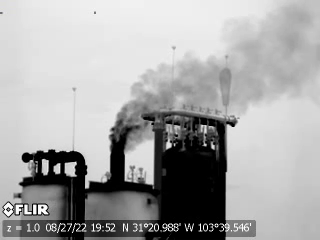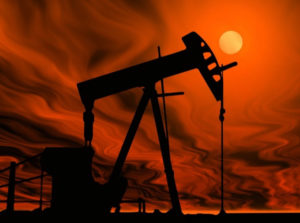Oil and gas sites are expected to have the most cutting edge technology reasonably available to them in order to reduce the amount of invisible, deadly gasses they are allowed to release into the air. But Earthworks’ Field Investigations reveal that relying on this technology lets the industry continue to get away with emitting gasses that cause a wide range of health problems, elevate cancer rates, and worsen the climate crisis.
During recent trips to the Permian Basin, the Texas Field Team at Earthworks observed a dense plume about a mile away coming from large pieces of equipment. Through optical gas imaging (OGI) cameras, we were able to document emissions coming from a well operated by Luxe Energy. The large skid of vertical tanks and liquid containers was a Streamline Innovations’ Valkyrie system. A few months later, we saw several more of these Valkyrie systems.

What Valkyries are supposed to do
The Valkyrie system was developed by Streamline Innovations as a mechanism to remove toxic hydrogen sulfide from natural gas and allow operators to sell gas that would otherwise be too toxic to enter into pipelines. Hydrogen sulfide has been linked to numerous worker deaths in addition to a litany of health effects from exposure. When burned, the gas combusts into sulfur dioxide, another gas harmful to human health that creates acid rain.
Due to this and its own high toxicity, operators remove hydrogen sulfide from natural gas in a process known as “sweetening” the gas. This is typically done at refineries or other large processing facilities. Some wells produce gas with so much hydrogen sulfide that the companies controlling pipelines are unwilling to accept the gas to bring to a refinery for sweetening. With nowhere to sell the gas, operators flare the gas they produce on site only keeping the oil that they produced.
Using a proprietary chemical cocktail called Talon, the Valkyrie equipment allows operators to sweeten their gas on site. Streamline claims that Talon is non-toxic. In theory, it converts the hydrogen sulfide into non-toxic elemental sulfur. This lets operators sell gas that would otherwise be too “sour” to enter into pipelines. Streamline Innovations advertised the equipment not just as a way to generate revenue from otherwise unsellable gas, but also as an emissions reduction technology. From a Streamline Innovation advertisement for the Valkyrie equipment:
“In addition, the sweetened gas is sold instead of flared, increasing the operator’s environmental performance, reducing emissions and increasing the site’s safety profile.”
The Talon chemical achieves all of this through a combination of reduction and oxidation reactions. This is a delicate process that requires real-time monitoring of the gas flow in order to make adjustments. In order to reduce manpower, Valkyrie makes these adjustments using a computer program which measures gas. This would be great if Valkyries actually worked.
What Earthworks documents Valkyries actually doing
Last month Earthworks visited multiple sites with Valkyrie units in the Permian Basin. Every single one was releasing emissions. One of them, Maple Energy’s Special Effort 18 site, had an overwhelming hydrogen sulfide odor that was so severe it made the entire Texas Field Team and two reporters all physically ill with headaches, burning eyes and nausea.

Even worse, the emission event that we witnessed for four days was not reported to the Texas Commission on Environmental Quality (TCEQ) as part of an upset event. This indicates the equipment was emitting continuously for at least four days—but likely longer. Perhaps most ludicrously, the original flare continued to operate with an additional flare, both burning off gas, even as the Valkyrie spewed pollutants into the air. Rather than decreasing flaring by allowing gas to go to the pipeline, the Valkyrie equipment appeared to be allowing gas to escape the system uncombusted (which is even worse than if the gas was just flared).
One might assume that this phenomenon is simply the result of bizarre happenstance at Special Effort 18. However, this trend occurred at four other sites nearby with flares operating while emissions blasted out of their Valkyries.
When the Texas Field Team returned to the site months later there was no improvement to emissions, even after complaints were made.
Where Valkyrie technology is used
The Valkyrie technology has quickly spread, both internationally and domestically. This has been bolstered by the versatility of the equipment. Versions of it are advertised for a variety of scales from one well all the way up to large refineries or even entire oil fields. Furthermore, the technology is advertised as having applications beyond oil and gas, such as in the production of helium.

Such a versatile “emissions reduction” technology is obviously highly appealing to investors and regulators alike. In fact, the premise of the Valkyrie equipment was so appealing that Streamline Innovations applied for and received a special low interest “sustainability-linked” loan from Riverstone Credit Partners. One of the Riverstone Credit Partners said that “Streamline has a demonstrated track record of helping its customers across multiple end markets improve environmental performance, reduce emissions and achieve ESG goals”.
The Inflation Reduction Act passed last month by Congress allocates more than $800 million to methane mitigation and monitoring. This means that sites are expected to have the most cutting edge technology reasonably available to them—such as Valkyries—in order to prevent emissions.
Conclusion
Despite being touted as the latest and greatest in emissions reduction, the Valkyrie and other attempts at innovating our way out of emissions chronically fail. The harsh reality is that the best control technology is to leave oil and gas in the ground.

